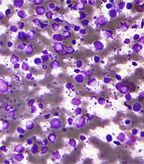Inotuzumab Ozogamicin/Rituximab Combo for Lymphoma Yields High Response Rates, Long PFS
The combination of two antibody-based targeting agents-inotuzumab ozogamicin and rituximab-demonstrated high response rates and long progression-free survival in patients with relapsed follicular lymphoma or relapsed diffuse large-B-cell lymphoma (DLBCL) in an international phase I/II multicenter, open-label study.
The combination of two antibody-based targeting agents-inotuzumab ozogamicin and rituximab (Rituxan)-demonstrated high response rates and long progression-free survival in patients with relapsed follicular lymphoma or relapsed diffuse large B-cell lymphoma (DLBCL) in an international phase I/II multicenter, open-label study. Findings were published ahead of print January 7 in the Journal of Clinical Oncology.

Micrograph of DLBCL, lymph node FNA specimen, field stain; source: Nephron, Wikimedia Commons
A dose-escalation phase to determine the maximum tolerated dose for the regimen was followed by an expanded cohort to further evaluate the efficacy and safety at the maximum tolerated dose, which was determined to be 375 mg/m2 rituximab (day 1) and 1.8 mg/m2 inotuzumab ozogamicin (day 2), once every 4 weeks.
A total of 118 patients with relapsed follicular lymphoma, relapsed DLBCL, or refractory aggressive non-Hodgkin lymphoma (NHL) received treatment with the combination every 4 weeks for up to eight cycles (median, four cycles).
The high response rates and progression-free survival, as well as the manageable toxicity profile, “suggest that rituximab/inotuzumab ozogamicin may be a promising option for CD20+/CD22+ B-cell non-Hodgkin lymphoma,” said lead author Luis Fayad, MD, of the MD Anderson Cancer Center, Houston. At maximum tolerated dose treatment, objective response rate was 87%, 74%, and 20% for patients with follicular lymphoma (n = 39), DLBCL (n = 42), and refractory aggressive NHL (n = 30), respectively. Confirmed complete response and unconfirmed complete response were achieved in 62% of patients with follicular lymphoma and 50% of patients with relapsed DLBCL. The 2-year progression-free survival rate was 68% (median, not reached) for follicular lymphoma and 42% (median, 17.1 months) for relapsed DLBCL.
Median duration of response was 17.7 months for relapsed DLBCL, 6.1 months for refractory aggressive NHL, and had not been reached for patients with follicular lymphoma at the time of this report (median follow-up, 40 months).
The most common adverse events included thrombocytopenia (56%), nausea (57%), fatigue (53%), increased AST (41%), neutropenia (33%), increased alkaline phosphatase (30%), and vomiting (28%). Most common grade 3/4 adverse events were thrombocytopenia (31%) and neutropenia (22%). Common low-grade toxicities included hyperbilirubinemia (25%) and increased AST (36%).
“With repeated dosing, patients with relapsed DLBCL or follicular lymphoma were able to tolerate a median of four to five cycles,” said Dr. Fayad. “At this dose and schedule, many patients with prior chemotherapy treatment may not be able to tolerate more than six cycles without dose delays or reductions.” The authors also noted that despite studies that have shown that inotuzumab ozogamicin directly binds to CD22 receptors and targets B cells, some nontarget toxicities also occur. These may be linked to cumulative exposure to inotuzumab ozogamicin after multiple cycles. Dose reductions after cycle 1 may allow some patients to tolerate more cycles.
“In the context of current treatments, activity of the combination of rituximab and inotuzumab ozogamicin is noteworthy,” said Dr. Fayad. “For relapsed/refractory follicular lymphoma, commonly used multi-agent chemotherapies, as well as the combination of rituximab and bendamustine yield high response rates (85% to 94%) and long progression-free survival (median, 33 months) in patient populations inclusive of those not previously treated with rituximab. Single-agent rituximab is expected to have objective response rates of approximately 50% in patients with relapsed/refractory follicular lymphoma. Thus, the combination of rituximab and inotuzumab ozogamicin appears to be promising therapy for patients with relapsed follicular lymphoma, including those with prior rituximab exposure, potentially being more efficacious than single-agent rituximab and a particularly good option for those not suited for intensive multi-agent therapies.”
Future studies comparing the combination of rituximab and inotuzumab ozogamicin to other chemotherapies will help define the role of this combination in treatment of CD22+ malignancies.
Support for this study was provided by Pfizer (formerly Wyeth Research). Inotuzumab ozogamicin was codeveloped with UCB, Brussels.